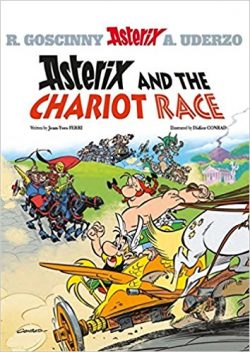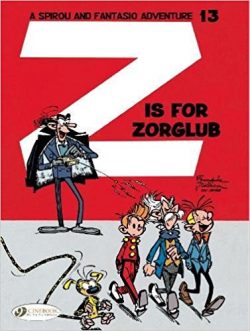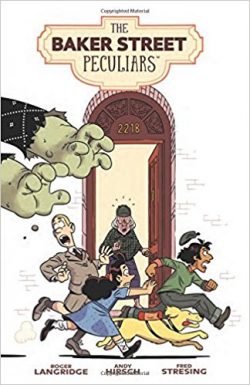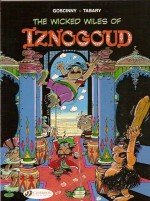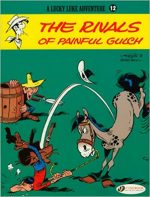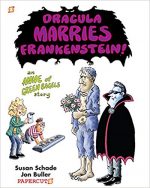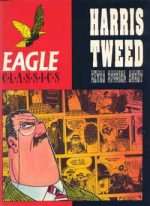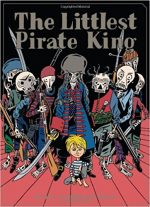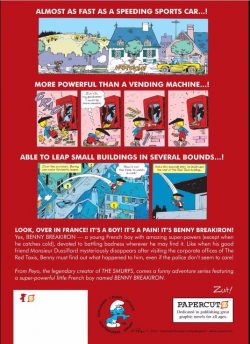
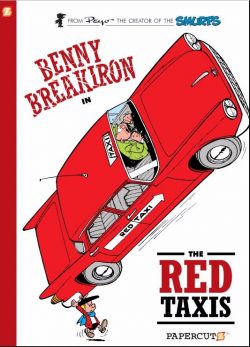
By Peyo, with backgrounds by Will, translated by Joe Johnson (Papercutz/NBM)
ISBN: 978-1-59707-409-4
Pierre Culliford was born in Belgium in 1928 to a family of British origin living in the Schaerbeek district of Brussels. An admirer of the works of Hergé and American comics in Mickey, Robinson and Hurrah!, he developed his own artistic skills but the war and family bereavement forced him to forgo further education and find work.
After some time toiling as a cinema projectionist, in 1945 he joined C.B.A. animation studios, where he met André Franquin, Morris and Eddy Paape. When the studio closed, he briefly studied at the Brussels Academy of Fine Arts before moving full-time into graphic advertising. In his spare time he began submitting comic strips to the burgeoning post-war comics publishers. His first sale was in April 1946: Pied-Tendre, a tale of American Indians in Riquet, the comics supplement to the daily L’Occident newspaper. Further sales to other venues followed and in 1952 his knight Johan found a permanent spot in Le Journal de Spirou. Retitled Johan et Pirlouit, the strip prospered and in 1958 introduced a strange bunch of blue woodland gnomes called Les Schtroumpfs.
Culliford – who now used the nom de plume Peyo – would gradually turn those adorable little mites (known to us and most of the world as the Smurfs) into an all-encompassing global empire, but before being sucked onto that relentless treadmill, he still found time to create a few other noteworthy strips such as the titanic tyke on view here today.
In 1960 Benoît Brisefer – AKA Benedict Ironbreaker or (in Dutch) Steven Sterk – debuted in Spirou #1183 (December 1960). With a few slyly added tips of the hat to Siegel & Shuster’s Superman (check out that cover, fanboys!), the wry bucolic adventures star a small boy with superhuman strength living in a generally quiet and unassuming little French – or maybe Belgian? – town.
Quiet, well-mannered, gentle and a bit lonely, Benny is also the mightiest boy on Earth; able to crush steel or stone in his tiny hands, leap huge distances and run faster than a racing car. He is also generally immune to all physical harm, but his only real weakness is that all his strength deserts him whenever he catches cold…
Benny never tries to conceal his powers but somehow the adults never catch on. They usually think he’s telling fibs or boasting and whenever he tries to prove he can bend steel in his hands the unlucky lad gets another dose of the galloping sniffles…
Most kids avoid him. It’s hard to make friends or play games when a minor kick can pop a football like a balloon and a shrug can topple trees...
Well-past it Brits of my age and vintage might remember the character from weekly comics in the 1960’s. As Tammy Tuff – The Strongest Boy on Earth – and later as Benny Breakiron and Steven Strong – our beret-wearing champion appeared in Giggle and other periodicals from 1967 onwards.
With Peyo’s little blue cash-cows taking up ever larger amounts of his concentration and time, other members of his studio assumed greater responsibilities for Benoît as the years passed. Willy Maltaite (“Willâ€), Gos, Yvan Delporte, François Walthéry and Albert Blesteau all pitched in and Jean Roba created many eye-catching Spirou covers, but by 1978 the demands of the Smurfs were all consuming and all the studio’s other strips were dropped.
You can’t keep a good super-junior down though, and, after Peyo’s death in 1992, his son Thierry Culliford and cartoonist Pascal Garray revived the strip, adding six more volumes to the eight generated by Peyo and his team between 1960 and 1978.
Thanks to the efforts of US publisher Papercutz, these gloriously genteel and outrageously engaging power fantasies are available to English-language readers again, both as robust full-colour hardbacks and eBooks, and this initial exploit begins in the sedate city of Vivejoie-la-Grande, where the sweet kid goes about his rather solitary life, doing good deeds in secret and being as good a boy as he can.
However, his sense of fair play is outraged when aging taxi driver Monsieur Dussiflard becomes the target of a dirty tricks campaign by new company Red Taxis. When he and the incensed cabbie challenge the oily company CEO in his flashy high-rise office, Benny is shooed away and the elderly driver later vanishes.
Suspicions aroused, the boy investigates and is attacked by a gang of thuggish Red Taxi employees. Only after thrashing and humiliating the goons does Benny realise that he still doesn’t know where Dussiflard is, so he throws the fight…
Just as he is imprisoned with his fellow abductee, the worst happens and the bombastic boy comes down with a stinker of a cold! As helpless as any other eight-year old, Benny is stuffed in a crate with the codger cabbie and loaded onto a freighter headed to the Galapagos Islands…
With all opposition ended, the boss and his Red Taxi stooges begin the final stage of their devilish plot, utterly oblivious to the dogged determination of Benny who must escape the ship and an alluring tropical paradise and impatiently wait for his cold to clear up, before setting off on a race against time, the elements and his own woefully-lacking knowledge of geography if he is to stop the ruthless criminals…
A superbly genteel spoof and fabulously winning fantasy about childhood validation and agency, The Red Taxis offers a distinctly Old World spin to the concept of superheroes and provides a wealth of action, thrills and chortles for lovers of incredible adventure and comics excellence.
© Peyoâ„¢ 2013 – licensed through Lafig Belgium. English translation © 2013 by Papercutz. All rights reserved.

